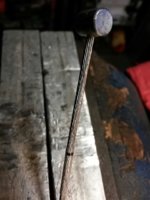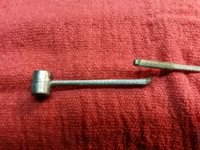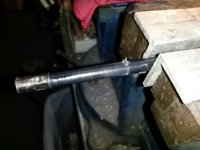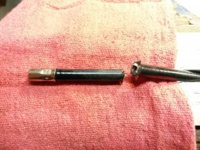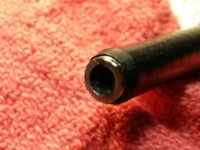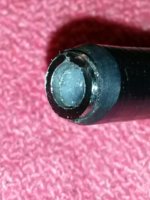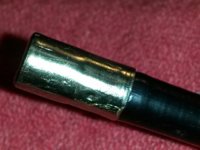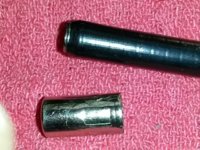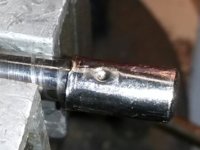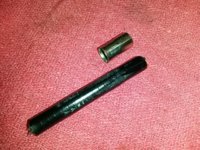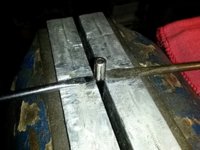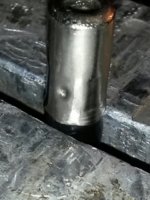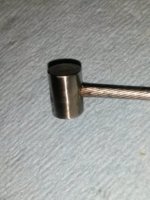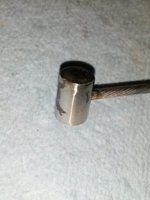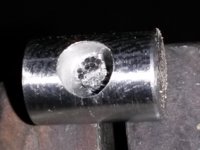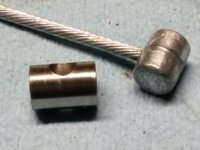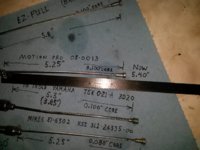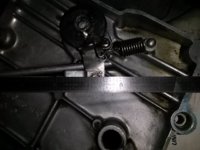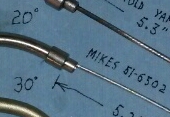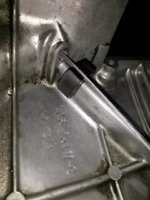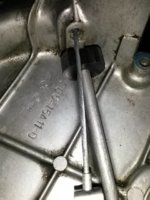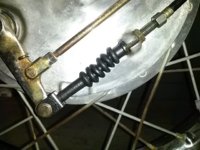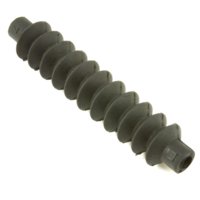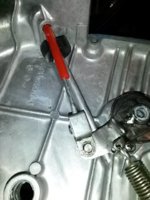Grading/Scoring
To help make sense out of the raw data, we'll use a scoring scheme, same as what was used on the clutch worm experiments. The score is mills-per-pound (shown as 'Sc' in the below reports). A higher number is better, it reflects a more efficient transfer of energy.
1 - 650Central EZ-Pull cable, 2.5mm (0.100") core diameter, no elbow.
2 - Motion Pro 05-0013, 2.5mm (0.100") core diameter , 12° elbow
3 - My old cable (16 yrs old, from Yamaha, similar to Motion Pro), 2.5mm (0.100") core diameter , 18° elbow
4 - MikesXS 51-6502 (KSI 3L1-26335-00), acquired several years ago, 2mm (0.080") core diameter , 20° elbow
5 - Yamaha 447-26335-00, 2mm (0.080") core diameter , 30° elbow
Straight/unrouted cables:
-- <30 lbs spring preload> | <40 lbs spring preload> | <60 lbs spring preload>
# - <Pull> - <Force> - <Sc> | <Pull> - <Force> - <Sc> | <Pull> - <Force> - <Sc>
1 - 0.405" - 10.5 lbs - 38.6 | 0.375" - 12.5 lbs - 30.0 | 0.355" - 16.5 lbs - 21.5
2 - 0.475" - 12.5 lbs - 38.0 | 0.455" - 15.5 lbs - 29.4 | 0.435" - 19.0 lbs - 22.9
3 - 0.485" - 13.0 lbs - 37.3 | 0.465" - 15.5 lbs - 30.0 | 0.435" - 20.0 lbs - 21.8
4 - 0.425" - 12.0 lbs - 35.4 | 0.420" - 15.0 lbs - 28.0 | 0.405" - 20.0 lbs - 20.3
5 - 0.445" - 12.5 lbs - 35.6 | 0.425" - 16.5 lbs - 25.8 | 0.415" - 19.5 lbs - 21.3
Cables routed on the bike:
-- <30 lbs spring preload> | <40 lbs spring preload>
# - <Pull> - <Force> - <Sc> | <Pull> - <Force> - <Sc>
1 - 0.355" - 13.0 lbs - 27.3 | 0.330" - 16.0 lbs - 20.6
2 - 0.450" - 15.5 lbs - 29.0 | 0.415" - 18.0 lbs - 23.0
3 - 0.425" - 14.0 lbs - 30.4 | 0.405" - 17.0 lbs - 23.8
4 - 0.415" - 14.0 lbs - 29.6 | 0.375" - 16.0 lbs - 23.4
5 - 0.420" - 14.0 lbs - 30.0 | 0.385" - 15.0 lbs - 25.7
For the straight/unrouted cables, you can see a pattern where the 0.100" cables score slightly higher than the 0.080" cables. They also have less bend in the elbow, which probably contributes to this.
For the routed cables (more realistic), the pattern changes. The 0.080" cables score similar to the 0.100" cables. Cable #1's score is strangely lower.
However, what I believe is the most important cable ranking measurement is the overall 'pull travel' in the routed (realistic) configuration. In this ranking, cable #2 is the leader, and will be used as my replacement cable.
The actual travel of the cable barrel fitting in the clutch lever is 0.600". The most that could be expected from cable #2 will be less than 0.500". With this in mind, the comments on the ideal worm arm clevis hole position (expecting 0.600" travel, as noted in the worm actuator experiment thread) can be ignored since the worm arm will not experience any significant overtravel with stock cable free length.
To help make sense out of the raw data, we'll use a scoring scheme, same as what was used on the clutch worm experiments. The score is mills-per-pound (shown as 'Sc' in the below reports). A higher number is better, it reflects a more efficient transfer of energy.
1 - 650Central EZ-Pull cable, 2.5mm (0.100") core diameter, no elbow.
2 - Motion Pro 05-0013, 2.5mm (0.100") core diameter , 12° elbow
3 - My old cable (16 yrs old, from Yamaha, similar to Motion Pro), 2.5mm (0.100") core diameter , 18° elbow
4 - MikesXS 51-6502 (KSI 3L1-26335-00), acquired several years ago, 2mm (0.080") core diameter , 20° elbow
5 - Yamaha 447-26335-00, 2mm (0.080") core diameter , 30° elbow
Straight/unrouted cables:
-- <30 lbs spring preload> | <40 lbs spring preload> | <60 lbs spring preload>
# - <Pull> - <Force> - <Sc> | <Pull> - <Force> - <Sc> | <Pull> - <Force> - <Sc>
1 - 0.405" - 10.5 lbs - 38.6 | 0.375" - 12.5 lbs - 30.0 | 0.355" - 16.5 lbs - 21.5
2 - 0.475" - 12.5 lbs - 38.0 | 0.455" - 15.5 lbs - 29.4 | 0.435" - 19.0 lbs - 22.9
3 - 0.485" - 13.0 lbs - 37.3 | 0.465" - 15.5 lbs - 30.0 | 0.435" - 20.0 lbs - 21.8
4 - 0.425" - 12.0 lbs - 35.4 | 0.420" - 15.0 lbs - 28.0 | 0.405" - 20.0 lbs - 20.3
5 - 0.445" - 12.5 lbs - 35.6 | 0.425" - 16.5 lbs - 25.8 | 0.415" - 19.5 lbs - 21.3
Cables routed on the bike:
-- <30 lbs spring preload> | <40 lbs spring preload>
# - <Pull> - <Force> - <Sc> | <Pull> - <Force> - <Sc>
1 - 0.355" - 13.0 lbs - 27.3 | 0.330" - 16.0 lbs - 20.6
2 - 0.450" - 15.5 lbs - 29.0 | 0.415" - 18.0 lbs - 23.0
3 - 0.425" - 14.0 lbs - 30.4 | 0.405" - 17.0 lbs - 23.8
4 - 0.415" - 14.0 lbs - 29.6 | 0.375" - 16.0 lbs - 23.4
5 - 0.420" - 14.0 lbs - 30.0 | 0.385" - 15.0 lbs - 25.7
For the straight/unrouted cables, you can see a pattern where the 0.100" cables score slightly higher than the 0.080" cables. They also have less bend in the elbow, which probably contributes to this.
For the routed cables (more realistic), the pattern changes. The 0.080" cables score similar to the 0.100" cables. Cable #1's score is strangely lower.
However, what I believe is the most important cable ranking measurement is the overall 'pull travel' in the routed (realistic) configuration. In this ranking, cable #2 is the leader, and will be used as my replacement cable.
The actual travel of the cable barrel fitting in the clutch lever is 0.600". The most that could be expected from cable #2 will be less than 0.500". With this in mind, the comments on the ideal worm arm clevis hole position (expecting 0.600" travel, as noted in the worm actuator experiment thread) can be ignored since the worm arm will not experience any significant overtravel with stock cable free length.

